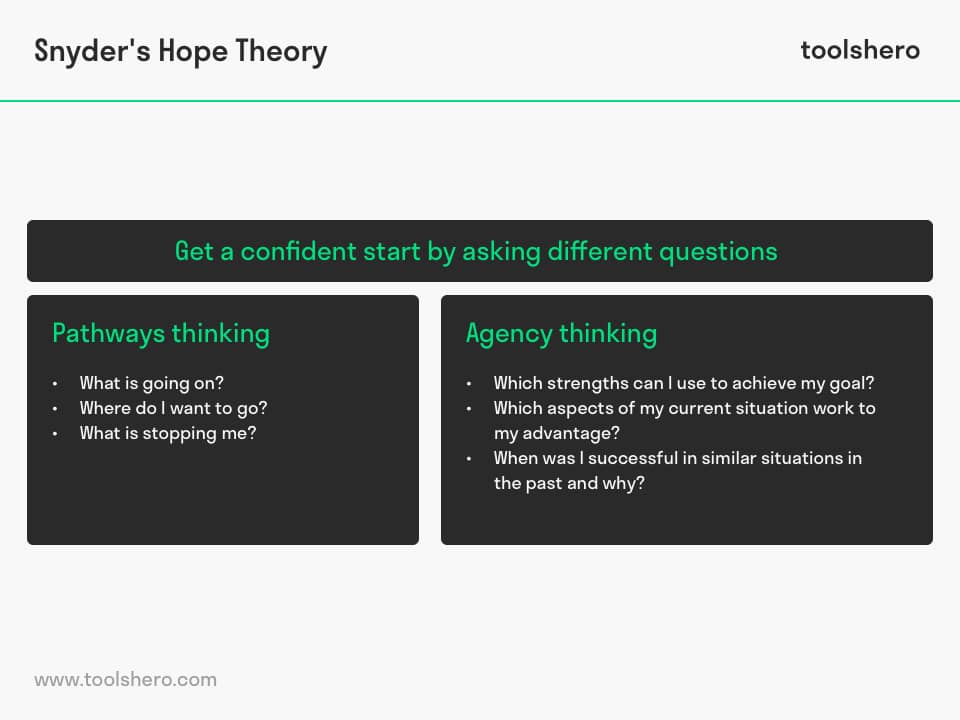Snyder’s Hope Theory

Snyder’s Hope Theory: this article provides a practical explanation of Snyder’s Hope Theory, developed by Charles Richard Snyder. After reading, you’ll understand the basics of this powerful psychology and personal development tool.
What is Snyder’s Hope Theory?
Charles Richard Snyder was an American psychologist specialised in positive psychology.
He garnered international fame for his work in clinical, social, personality, and health psychology. His theories from the ’80s and ’90s relate to, among other things, human responses to personal feedback, human need for uniqueness, and the hope motive.
Based on Snyder’s work, more studies were conducted to link increased levels of hope to academic and athletic performance and physical health and well-being.
By helping people become so-called high-hopers, they gain a more positive outlook on life. In simplified terms, this is what Snyder’s Hope Theory is about.
Three Components within Snyder’s Hope Theory
When talking about Snyder’s Hope Theory, it’s helpful to first define the word ‘hope’.
Hope can be seen as the perceived ability to walk certain paths leading to a desired destination. In addition, hope helps people stay motivated when walking these paths.
Hope consists of both cognitive elements and affective elements. Snyder’s Hope Theory includes goals, paths, and freedom of choice.
According to Charles Richard Snyder, there are at least three components that people can relate to hope, being:
- you need to have focused thoughts
- you must develop strategies in advance in order to achieve these goals
- you have to be motivated to make the effort required to actually reach these goals
The more the individual believes in their own ability to achieve the components listed above, the greater the chance that they will develop a feeling of hope.
Pathways and Agency Thinking
Goals are abstract and mental. They have the power to guide human behaviour. Snyder noticed that much of human behaviour is goal-oriented.
In addition to the previously mentioned components, Snyder’s Hope Theory therefore distinguishes two other important factors that influence movement towards the goal:
Pathways thinking
This is about the human ability to generate different pathways from the present to the desired future.
Pathways focus on the perceived ability to plan multiple routes. This is about the cognitive ability to produce a pathway that leads to the goal, and to first think about it.
Agency Thinking
This refers to the level of intention, confidence, and the human ability to actually follow those different pathways to the desired future. The belief and positive motivation to follow the path are key here. This is about affective ability.
Positive emotion
The goals themselves also play an important role in Snyder’s Hope Theory. Goals that are valuable but uncertain are described as the anchors of Snyder’s Hope Theory. They offer direction and guide you to the final destination. Barriers can also play a role. They may make it difficult to reach the goals.
If there’s a barrier, an easy solution would be to quit unless Pathways Thinking is strengthened to create a new pathway.
Reaching goals will happen more easily if emotions are positive. In many cases barriers lead to negative emotions.
By coming up with new, alternative pathways, the conviction and motivation from Agency Thinking is reactivated, making it possible to reach the goal sooner. Barriers are then considered challenges, not permanent roadblocks.
The key in Snyder’s Hope Theory requires different pathways to a goal and the intention to stick to those paths.
It’s about a cyclical relationship between Pathways and Agency Thinking, with Pathways Thinking leading to more routes. The development of more routes in turn leads to Agency Thinking and positive emotions.
Positive Psychology Practitioner Diploma | Happiness Science
Discover the Path to Happiness and Success | Level 1 Certification. Cultivate and Embrace Positive Well-being Techniques
Asking questions
In order to get a confident start in Snyder’s Hope Theory, it helps to ask different questions, such as ‘What is going on?’ and ‘Where do I want to go?’ and ‘What is stopping me?’ These are typical Pathways Thinking questions.
From Agency Thinking, you could ask questions such as, ‘Which strengths can I use to achieve my goal?’, ‘Which aspects of my current situation work to my advantage?’, and ‘When was I successful in similar situations in the past and why?’
When generating options to reach the final goal, it’s also helpful to invoke a powerful thought that contains the belief that you can truly do it.
When you do this, Pathways Thinking is no longer about different options; it will also reinforce Agency Thinking. This gives you strength, making it more likely that you will reach the goal.
Snyder’s Hope Theory: evaluation tool
In addition to the Snyder’s Hope Theory, the American psychologist also came up with an evaluation tool. He developed it to measure hope. Regarding Snyder’s Hope Theory, this became the Adult Dispositional Hope Scale (ADHS), intended to measure hope in people over fifteen years old.
It’s a self-assessment. The evaluation tool consists a questionnaire with twelve questions; six focused on Pathways Thinking and another six focused on Agency Thinking.
The Pathways questions are about the cognitive ability to come up with creative steps towards the goal.
The Agency questions are about the affective part of the brain and the sense, motivation, and belief that people have to strive towards the goal.
Each question lets the respondent fill in a rating from 1 to 8 according to the Likert Scale; 1 indicates least recognition, while 8 means most recognition with regard to the question.
The scale then comes up with three scores; a hope score focused on Agency and Pathways questions together, and two separate scores for both. The total scores can vary from 8 to 64. The higher the score, the more hope a person has.
Now it’s your turn
What do you think? Do you recognize the explanation of Snyder’s hope theory? What do you think about the 3 mentioned components that are associated with hope? Can you actually put both pathways thinking and agency thinking into practice? Do you have any tips or comments?
Share your experience and knowledge in the comments box below.
More information
- Snyder, C. R. (Ed.). (2000). Handbook of hope: Theory, measures, and applications. Academic press.
- Snyder, C. R. (2002). Hope theory: Rainbows in the mind. Psychological inquiry, 13(4), 249-275.
- Snyder, C. R., Rand, K. L., & Sigmon, D. R. (2002). Hope theory. Handbook of positive psychology, 257-276.
- Pegg, M. (unknown). S is for Rick Snyder: His Work On Hope. Retrieved from : https://www.thepositiveencourager.global/h-rick-snyders-work-hope/.
How to cite this article:
Mulder, P. (2019). Snyder’s Hope theory. Retrieved [insert date] from Toolshero: https://www.toolshero.com/personal-development/snyders-hope-theory/
Original publication date: 25/11/2019 | Last update: 12/19/2023
Add a link to this page on your website:
<a href=”https://www.toolshero.com/personal-development/snyders-hope-theory/”>Toolshero: Snyder’s Hope Theory</a>













